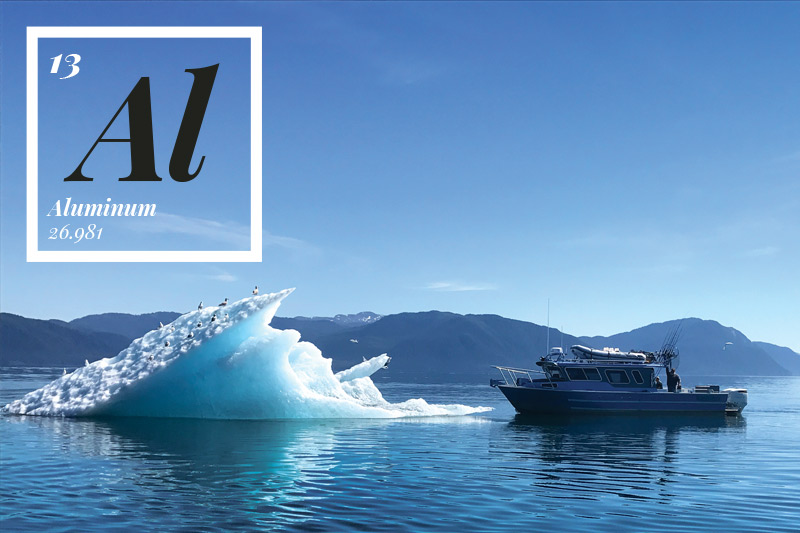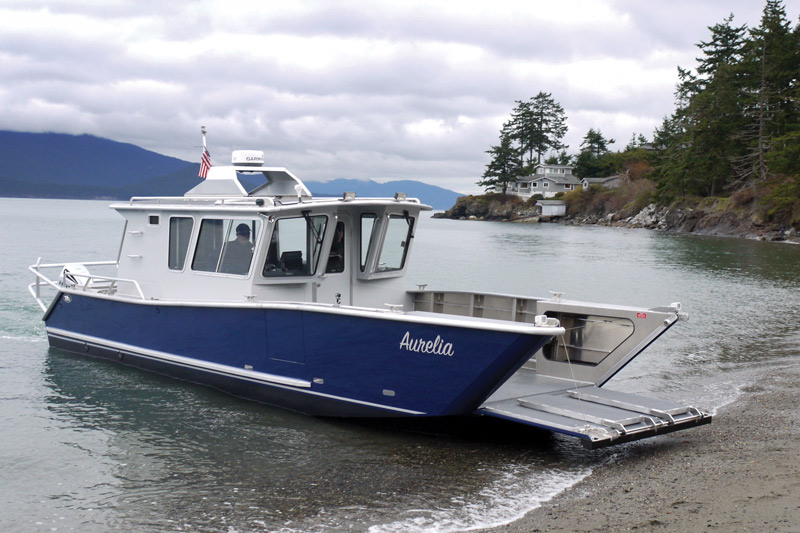
 However, boaters in the Pacific Northwest, and to a certain extent in California and the Midwest, have known for years that aluminum as a boat building material has very useful properties. Notably, so have the builders of water taxis, crew boats, high-speed ferries, commercial fishing vessels, and U.S. Coast Guard rescue boats.
However, boaters in the Pacific Northwest, and to a certain extent in California and the Midwest, have known for years that aluminum as a boat building material has very useful properties. Notably, so have the builders of water taxis, crew boats, high-speed ferries, commercial fishing vessels, and U.S. Coast Guard rescue boats.
A local builder, Coastal Craft of Gibson B.C., builds exclusively in aluminum and the quality of Coastal builds rank among the best. Alexander Marine, another large yacht builder that’s popular in Pacific Northwest waters, makes extensive use of aluminum beams as structural elements in its fiberglass boats. Outside of the Pacific Northwest, two of the world’s leading U.S. custom yacht builders, Burger and Palmer Johnson, both household names when it comes to large private vessels and both located in Wisconsin, build exclusively with aluminum. Another Eastern U.S. boat builder, Rinker, touts the advantage of its aluminum radar arch over those made of fiberglass. What’s more, the hulls of most air boats in the Southeastern U.S. are also built of aluminum, and they take quite a pounding.
Aluminum as an element is one of the most common minerals in the earth’s crust, but it has been around as the metal we know since the early 1800s when small amounts were created in labs by academics. In about 1866, Frenchman Paul Héroult and Charles Martin Hall, an American, each applied for a patent in his own country for the electrolytic reduction process (smelting), which made commercial production of aluminum at reasonable prices possible. The same basic process is used today.
Pure aluminum is soft and weak and has no value in the marine field. However, when alloyed with other elements, including manganese, magnesium, copper, zinc, and silicone, it becomes useful as an industrial and marine metal. Aluminum alloys have numerical designations, and the marine grade designations are in the 5000 and 6000 series. The American Society for Testing and Materials [ASTM] has designated marine grade aluminum as B 928. ASTM is an international organization wherein members voluntarily agree on standards.

Aluminum, when exposed to the oxygen in the air, is one of the few metals that naturally forms aluminum oxide, a hard, tough coating that is impervious to saltwater. Aluminum oxide has chemical properties similar to sapphire, which makes it very hard. On the Mohs Scale of Hardness – where diamond is the hardest with a ten rating – sapphire rates a nine. Since the tough aluminum oxide protects the metal against the elements, painting is not required except for cosmetic or anti- fouling purposes. This also applies to the inside of an aluminum hull.
Unpainted aluminum is a dull, grey color like the unpainted sections of most commercial airliners (almost all of which are made of aluminum). Unpainted aluminum surfaces can sit exposed to the sun, wind, and rain for years without damage. More than 50 years ago, most of the small car-top boats were made of riveted, very thin, aluminum. They were tough and many of them are still around today, although they are somewhat the worse for wear. All that is usually required after an aluminum boat has sat out in the elements for years is to scrub it down with freshwater, soap, and a plastic scrub pad —the type usually used on barbecue grills works well. The soap can be optional!
Experienced boaters know that painting any boat can be expensive—and in some cases very expensive—so many aluminum boat owners forego that expense and instead use glue on vinyl stripes to cosmetically dress up their boats. These stripes, much like pin striping in the auto world, are inexpensive and can be easily applied without professional help.
Coastal Craft
Coastal Craft is considered by many to be one of the best aluminum yacht builders in the world.
Address: 1038 Venture Way, Gibsons BC V0N 1V7, Canada
Website: coastalcraft.com
Phone: 604-886-3004
Inventech Marine Solutions:
This relatively new company makes the tough, high-performance Life Proof Boats line of planning aluminum boats.
Address: 8585 SW Warrior Dr., Bremerton, WA 98312
Website: inventechmarine.com
Phone: 360-674-7019
Daigle Welding & Marine LTD.:
British Columbia-based Daigle Welding makes the rugged EagleCraft line of aluminum sport and cruising craft.
Address: 2177 Island Hwy, Campbell River, BC, Canada, V9W 2G6
Website: eaglecraft.bc.ca
Phone: 888-393-6464
Munson Boats:
This company makes a variety of aluminum vessels ranging from recreational sport boats to commercial craft.
Address: 15806 Preston Place Burlington, WA 98233
Website: munsonboats.com
Phone: 360-707-2752
North River Boats:
North River is an employee-owned company out of Oregon that mostly makes fishing machines made for the river and inland waters.
Address: 1750 SW Green Siding Rd., Roseburg, OR 97471
Website: northriverboats.com
Phone: 541-673-2438
With twice the yield strength and ten times the shear strength, aluminum is much stronger and tougher than the typical fiberglass lay-up used in boats and weighs about the same. Since aluminum is much tougher than fiberglass, aluminum boats can withstand a hard docking or grounding much better than their fiberglass cousins.
A scratch or gouge on an aluminum hull will begin to oxidize immediately and no repair is required. By comparison, a scratch or gouge through the gel coat on a fiberglass boat should be repaired immediately to ensure water does not wick into the laminate.
Water wicking into a glass laminate will, especially if freezing weather hits, start a structural delamination.
Should an aluminum boat be holed, it can be temporarily patched in the field and in some cases right in the water. The area around the hole can be sanded lightly with fine sandpaper and ringed with a generous amount of sealant. A thin piece of aluminum or plywood can then be screwed over the hole with stainless, self-tapping screws.
If the boat can’t be hauled, a small piece of a tarp can be slid over the hole on the outside of the hull. The water entering through the hole will force the material against the side and stop the water. The patch can then be put on from the inside.
Aluminum boats can also be patched with an epoxy putty material sold in most marine stores in stick form. A piece of putty, large enough to fill the hole, is kneaded for about a minute and then forced into the hole. It sets up rapidly and, once set, can last for months.
Most aluminum boats for saltwater use are welded and this offers a great advantage since almost all fittings—cleats, hand rails, toe rails, center consoles, anchor pulpits, fishing towers, etc.—can be welded directly to the hull. This removes the likelihood of screws working free of the fittings and other attachments as they often do on other boats. It also means that fittings can be attached anywhere on an aluminum hull.
A big advantage to being able to weld aluminum fittings directly to the aluminum hull structure is that there is no possibility of galvanic corrosion that is likely if a stainless cleat were to be screwed or bolted to a gunnel. Even a plastic fitting has to be fixed to the hull with regular steel, or stainless steel screws or bolts. Dissimilar metals in salt water leads to galvanic corrosion. So far nobody has developed aluminum screws or bolts strong enough to be used to fasten fittings to hulls.
Many boaters believe, mistakenly, that metal boats attract lightning. In fact, metal boats are no more likely to be struck by lightning than their glass counterparts. But if they are struck, the electrical energy passes directly into the water, much like the grounding wire on a lightning rod, doing little or no damage to the boat and its occupants. It’s the same principle as a Faraday Cage, an enclosure that acts like a hollow conductor to block electromagnetic fields.
It may appear that aluminum is a maintenance-free material, but that’s not the case. There is no such thing as a maintenance-free boat building material. Aluminum boats need to be maintained, but the maintenance takes a different form. Instead of the usual, and seemingly endless, scraping, painting, buffing, and polishing, the aluminum boat owner simply keeps his or her bilges clean.
Aluminum boats can suffer from what is known as galvanic corrosion. That’s corrosion resulting from two dissimilar metals coming into contact with each other in an electrolyte. Saltwater is a good electrolyte. An aluminum boat owner must make sure there are no steel or copper nuts and bolts left in the bilges and that, like steel boats, sacrificial anodes are properly installed.

If a boater wants to add fittings that must be screwed or bolted down, stainless screws, or nuts and bolts with isolating washers, should be used. Isolating gaskets can also be used to effectively isolate the steel fitting from the aluminum thereby reducing the likelihood of galvanic corrosion.
Since aluminum clearly has certain advantages, many often ask why aluminum is not used as a building material for large freighters. It is much lighter than steel and a freighter could, therefore, carry a heavier load. Steel weighs 487 pounds per cubic foot while aluminum weighs in at 165 pounds for the same volume. Steel is also much tougher than aluminum. On Mohs 1-10 scale of hardness aluminum is 2.5 – 3 and steel is 7-8. The hardness varies depending on the other metals alloyed into the steel or aluminum during the smelting process.
For those used to working in steel, the switch to working with aluminum can sometimes be a bit of a problem. The traditional method of metal cutting in steel is with an oxy-acetylene cutting torch, but the very thing that makes aluminum corrosion resistant in salt water – the oxide coating – is also the very thing that creates a problem when trying to cut the material with oxy-acetylene. The melting point of the aluminum oxide is about 1,000 Cº while the melting point of the aluminum itself is about 600 Cº.
By the time the oxide is burned through, the aluminum has melted into a puddle. Luckily aluminum can be easily cut with standard woodworking tools equipped with carbide tipped blades.
Aluminum is making major inroads into the marine field beyond just as a building material. It is rapidly
replacing zinc as the main metal in sacrificial anodes used to combat galvanic in boats generally. While there are no perfect boat building materials, aluminum comes very close to being one for many marine applications.